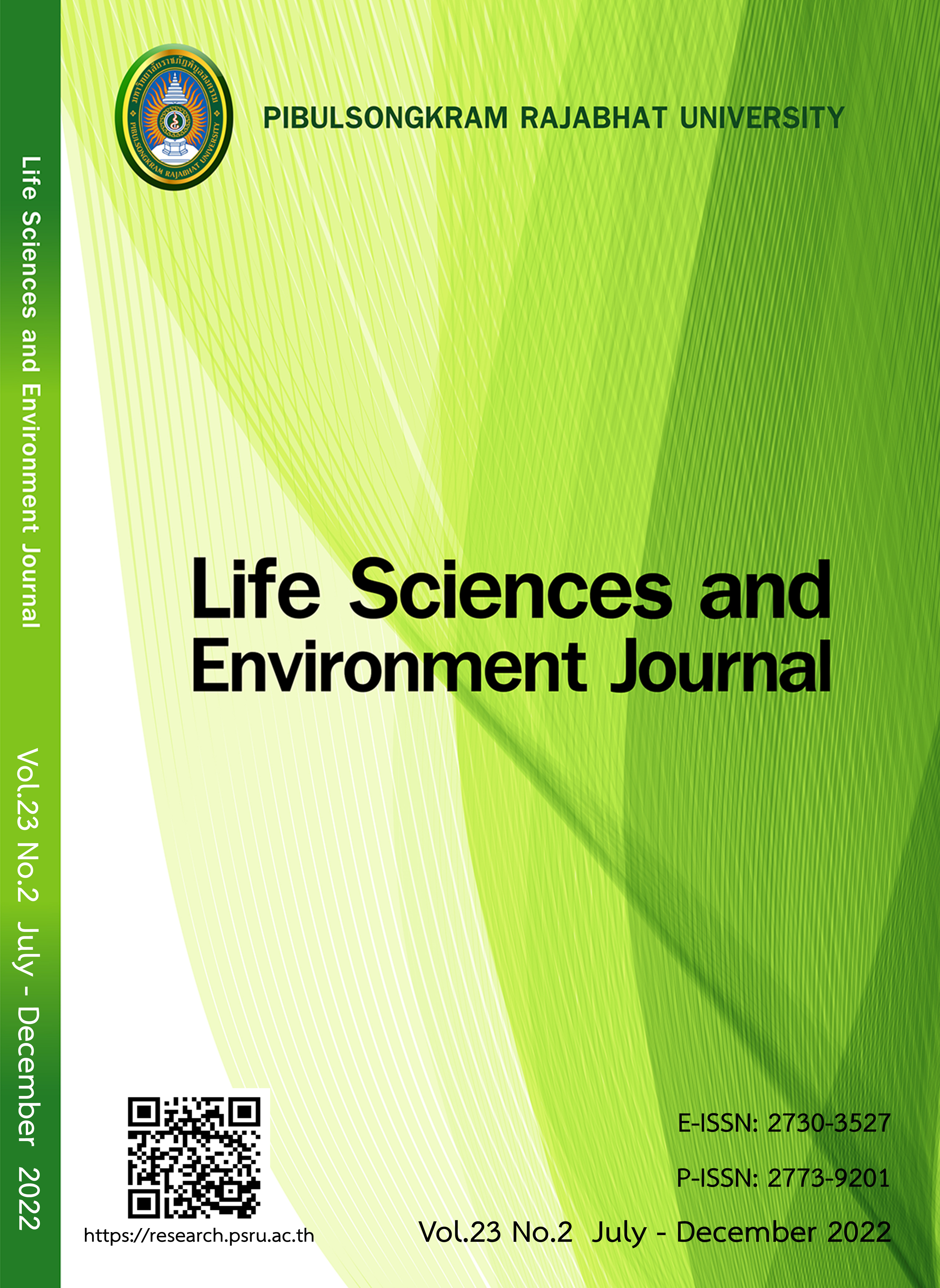CHEMICAL COMPOSITIONS, ANTIOXIDANT AND ANTI-GLYCATION ACTIVITIES OF BERRY FRUIT TEA INFUSIONS
DOI:
https://doi.org/10.14456/lsej.2022.36Keywords:
Fruit tea, Berry, Phenolic compound, Antioxidant, Anti-glycationAbstract
This research aimed to prepare 4 types of berry tea i.e. blackberry, cranberry, raspberry and mulberry. The chemical composition, antioxidant and anti-glycation activities in berry tea infusions were determined. Samples of fresh berries were freeze-dried, ground into a fine powder and infused in hot water at 90-100oC for 3 min. The total phenolic content was assessed based on the Folin-Ciocalteu method. The antioxidant activity was studied by DPPH free radical scavenging method and ferric-reducing antioxidant power. The anti-glycation activity was studied using a spectrofluorophotometer.
Main phenolic compounds were analyzed by high-performance liquid chromatography. Mulberry fruit tea showed the highest content of phenolic (24.45 mg GAE/g DW), DPPH free radical scavenging activity (94.49 %) and anti-glycation activity (75.83 %). The main phenolic acids found in mulberry tea were gallic acid, chlorogenic acid and coumaric acid (0.38, 0.64, 2.42 mg/g, respectively). The propose fruit tea could be an alternative to make use of berries which were valuable sources of phenolic compounds, antioxidant and anti-glycation that could result in age-related alterations.
References
Adisakwattana S. Cinnamic acid and its derivatives: Mechanisms for prevention and management of diabetes and its complication Nutrients 2017;9(2):1-27.
Benzie IFF, Strain JJ. The ferric reducing ability of plasma (FRAP) as a measure of “antioxidant power”: the FRAP assay. Analytical Biochemistry 1996;239:70-76.
Bilawal A, Ishfaq M, Gantumur M-A, Qayum A, Shi R, Fazilani SA, Anwar A, et al. A review of the bioactive ingredients of berries and their applications in curing diseases. Food Bioscience. Published online December, 2021.
Butsat S, Siriamornpum S. Phenolic acid and antioxidant activities in husk of different thai rice varieties. Food Science and Technology International 2010;16(4):329-336.
Brand-williams W, Cuvelier ME, Berset C. Use of a free radical method to evaluate antioxidant activity. Food Science and Technology 1995;28:25-30.
Deetae P, Parichanon P, Trakunleewatthana P, Chanseetis C, Lertsiri S. Antioxidant and anti-glycation properties of Thai herbal teas in comparison with conventional teas. Food Chemistry 2012;133: 953-959.
Prior RL, Wu X. Diet antioxidant capacity: relationships to oxidative stress and health. American Journal of Biomedical Science 2013;5(2):126-139.
Gong Y, Liu X, He WH, Xu HG, Yuan F, Gao YX. Investigation into the antioxidant activity and chemical composition of alcoholic extracts from defatted marigold (Tagetes erecta L.) residue. Fitoterapia 2012;83:481-489.
Hunyadi A, Martins A, Hsieh T, Seres A, Zupko I. Chlorogenic acid and rutin play a major role in the in vivo anti-diabetic activity of Morus alba leaf extract on type II diabetic rats, PLoS ONE 2012;7:1-6.
Katarina S, Gordana Z, Teodora J, Dejan G, Tatjana S, Dejan P. Berry fruit teas: Phenolic composition and cytotoxic activity. Food Research International 2014;62:677–683.
Kaewkaen P, Tong-un T, Wattanathorn J, Muchimapura S, Kaewrueng W, Wongcharoenwanakit S. Mulberry fruit extract protects against memory impairment and hippocampal damage in animal model of vascular dementia. Evidence-based complementary and alternative medicine 2012;(5):263520:1-9.
Methaakkharadecha N, Srisopa A. Phenolic contents and antioxidant activities of Mulberry leaf tea and water soluble Mulberry leaf tea powder. Thai Journal of Science and Technology 2020;9(2):30-242.
Radojkovi MM, Zekovi ZP, Vidovi SS, Kocar DD, Maskovi PZ. Free radical scavenging activity and total phenolic and flavonoid contents of mulberry (Morus spp. L., Moraceae) extracts. Hemijska Industruja 2012; 66(4):547–552.
Rohela GK, Shukla P, Muttanna, Kumar R, Chowdhury SR. Mulberry (Morus spp.): An ideal plant for sustainable development. Trees Forests and People 2020;2:10-12.
Silva JK, Batista AG, Cazarin CBB, Dionisio AP, Brito ES, Marques ATB, Marostica MR. Functional tea from a Brazilian berry: Overview of the bioactives compounds. Food Science and Technology 2017;16(76): 292-298.
Souza VR, Pereira PAP, Silva TLT, Lima LC, Pio R, Queiroz F. Determination of the bioactive compounds, antioxidant activity and chemical composition of Brazilian blackberry, red raspberry, strawberry, blueberry and sweet cherry fruits. Food Chemistry 2014;156:362-368.
Srisopa A, Wongkrajang K. Development of antioxidant and anti-α-glucosidase mulberry leaf tea recipes with combination of aroma herbs, Thai Journal of Science and Technology 2020;9(2):218-229.
Wen P, Hu TG, Linhardt RJ, Liao ST, Wu H, Zou, YX. Mulberry: A review of bioactive compounds and advanced processing technology, Trends in Food Science & Technology 2019;83:138-158.
Vichasilp C, Srithupthai K, Wangtueai S. Development of fruit tea from Mao (Antidesma sp.) seeds; by-products from Mao juice and wine processing. Khon Kaen Agriculture Journal 2017;45(2):393-400.
Zhao W, Cai P, Zhang N, Wu T, Sun A, Jia G. Inhibitory effects of polyphenols from black chokeberry on advanced glycation end-products (AGEs) formation. Food Chemistry. Published online October 30, 2022.
Downloads
Published
How to Cite
Issue
Section
License
Copyright (c) 2022 Life Sciences and Environment Journal

This work is licensed under a Creative Commons Attribution-NonCommercial-NoDerivatives 4.0 International License.
Each article is copyrighted © by its author(s) and is published under license from the author(s).










